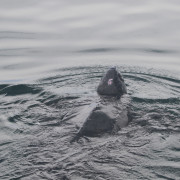- Science News
- Environment
- Who will profit when territories of Europe’s predators overlap? Here are five Frontiers articles you won’t want to miss
Who will profit when territories of Europe’s predators overlap? Here are five Frontiers articles you won’t want to miss
by Deborah Pirchner, Frontiers science writer
Image: Shutterstock.com
At Frontiers, we bring some of the world’s best research to a global audience. But with tens of thousands of articles published each year, it’s impossible to cover all of them. Here are just five amazing papers you may have missed.
Carnivore territories might soon overlap – and some species profit more than others
Some of Europe’s large carnivore populations, including jackals and lynxes, are growing and expanding their territories. The golden jackal, a wolf-like generalist that once occupied only the Balkan area, is currently expanding its territory. At the same time, the Eurasian lynx, a specialized predator previously hunted close to extinction, is slowly recovering.
Writing in Frontiers in Ecology and Evolution, researchers have now modeled jackal and lynx distribution in Europe for current and future scenarios. Currently, it is estimated that the overlap of jackal and lynx territories is 13%. This overlap is likely to increase, given both species’ expansion.
The researchers’ findings showed that both predators expanding their territories, leading to a dynamic where they coexist for the first time, may favor one species and threaten the other: Their predictions show an increase in habitat suitability for the golden jackal, while an opposite trend is predicted for the Eurasian lynx.
Article link: https://www.frontiersin.org/articles/10.3389/fevo.2023.1165968/full
Variations in running biomechanics between men and women lead to different fracture risk
During strenuous physical activities, which are part of military basic combat training, women have been found to be four times as likely as men to suffer fractures of the lower leg bone.
Scientists in the US now have investigated differences in running biomechanics between young, healthy women and men under different load-carriage conditions and evaluated sex-specific differences in joint kinetics and kinematics, as well as the associated risk of tibial stress fracture (SF) during a 10-week US Army basic combat training. They published their results in Frontiers in Bioengineering and Biotechnology.
Across all load conditions (0kg, 11.3kg, 22.7kg), women had a significantly smaller flexion angle at the trunk than men. Under load-carriage conditions, women had a larger flexion angle at the hip than men, and also displayed significantly different joint kinematics at the trunk and knee. These findings indicated that women had a greater increase in tibial strain and SF risk than men as load increases, indicating higher susceptibility to injuries.
Article link: https://www.frontiersin.org/articles/10.3389/fbioe.2023.1250937/full
Intense emojis influence emotional interpretation of neutral texts
Much of our daily conversation is done via text. To compensate for the lack of pragmatic information, texters often add emojis to their texts. Researchers have no examined if strong emojis change the interpretation of texts more than weak emojis.
Writing in Frontiers in Psychology, they investigated if a negative text is paired with a strong negative face emoji, will it be interpreted more negatively than a negative text paired with a mild negative face emoji. They also used mild and strong positive emojis to evaluate their effect of positive texts.
Slightly negative texts paired with strong negative emojis (eg angry face) were rated more negatively than slightly negative texts paired with mild negative emojis (eg confused face). Slightly positive texts paired with mild positive emojis (eg grinning face with big eyes) were rated more positively than the same texts paired with strong positive emojis (eg beaming face with smiling eyes). Emojis can, therefore, impact the interpretation of text messages, the researchers concluded.
Article link: https://www.frontiersin.org/articles/10.3389/fpsyg.2023.1183299/full
How sniffer dogs could help conserve endangered Tasmanian devils
Effective captive breeding of endangered animals is largely about timing, but catching the right window is difficult. Yet, identifying the period when females are receptive to mating – also known as oestrus – is vital. Sniffer dogs may provide a non-invasive method to determine female receptivity, researchers wrote in Frontiers in Veterinary Science.
Because of their excellent sense of smell, sniffer dogs are increasingly employed to detect various biological odors and metabolic states and may present a novel technique for identifying oestrus in captive wildlife, such as the endangered Tasmanian devil. For their study, researchers collected fecal samples from 11 Tasmanian devil females and trained three scent detection dogs so that they would be able to discriminate between oestrus and non-oestrus devil fecal samples.
When assessed on training samples, dogs were able to correctly identify oestrus samples with a mean sensitivity of 69.1%. When assessed on novel samples, their sensitivity to oestrus dropped to 48.6%.
Article link: https://www.frontiersin.org/articles/10.3389/fvets.2023.1224172/full
Coral diseases identified at world’s most southern coral reef ecosystem for the first time
Recently, coral disease has been increasing significantly. Disease impacts both the community structure and functionality of reefs, but little is known about what the effects are in reefs located at high latitudes – above 28° north and below 28° south – which are particularly vulnerable to climate change.
Now, writing in Frontiers in Ecology and Evolution, researchers in Australia reported the first coral disease findings at the UNESCO World Heritage listed Lord Howe Island Marine Park, the world’s most southern reef system. They identified four coral diseases affecting six corals. White syndrome, a disease that kills coral tissue and leaves a white calcium carbonate skeleton behind, was the most prevalent disease.
The reasons why diseases occur at Lord Howe Island Marine Park could be the result of a number of factors, including environment parameters, host susceptibility, and the way diseases are transmitted from coral to coral. Continuous monitoring of the reef is imperative, the researchers said.
Article link: https://www.frontiersin.org/articles/10.3389/fevo.2023.1194485/full
REPUBLISHING GUIDELINES: Open access and sharing research is part of Frontiers’ mission. Unless otherwise noted, you can republish articles posted in the Frontiers news site — as long as you include a link back to the original research. Selling the articles is not allowed.




